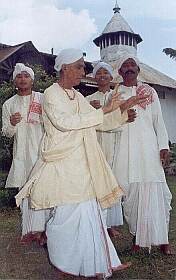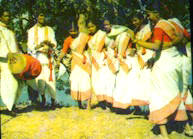FOLK ART & CULTURE
Darrang has a population representing diverse ethnic, religious and linguistic communities which have rich cultural heritage and social customs. Some of the prominent art forms of the Darrang are:
This art form is performed by men (Dhuliyas) in
groups of 10 or more. Dhuliyas play Bardhol which is a cylindrical
percussion instrument measuring about 1 mtr. in length & 1/2 mtr. in diameter. The Bardhuliyas
speciallise in exhibition of rhythmic somersaults while playing the Bardhol. Bardhuliyas
perform in religious occasions such as Deul in spring, the Mothenee in Kati
(Nov. in Julian calendar) month, Durga festival (mid. of Oct.) or other
ceremonies.
 Bardhol Sequence,(301 kB)
Bardhol Sequence,(301 kB)
Ojapali is one of the unique form of arts of Darrang which involves three art forms - Song, Dance and Drama. It is performed by a group of 4 or 5 men of whom the chief performer is called Oja who is supported by 3 to 4 Palis, and hence the name Ojapali.. The only instrument played by Ojapali is Khutitaal (palm sized Cymbal). The performers wear long sleeved white gowns, silver jewelry etc. and Nupur (bundle of tiny metallic percussions played by body vibrations).
Byah Ojapali
Ojapali can be divided into 2 forms basing on the occasion & style: Byah and Sukananni. As the history goes, there were two very talented singers named Barbyahu & Sarubyahu during Koch Kingdom. They were often invited by Kings to sing various mythological & religious rhymes. With time, their style got popular among people of the area.
The central subject of this Byah Ojapali are the epics - Ramayana & Mahabharata. Unlike other Ojapali forms, the story is sung in pure classical style involving Ragas. A noticeable element of this form is the different Mudras (Gestures of hands & fingers). Dance is another key part of the performance. To make the presentation interesting & make people understand, they perform humorous dialogues & narrations in between.

Sukananni Ojapali aims at presenting the
tragic story of Behulaa-Lakhindar from Padma Purana among the masses.
The easy yet high standard rhyme is accompanied by pleasant rhythm, tune and dance.
Different Mudras are remarkable part of this form also. The team dances here too.
This art is performed normally during Manasa Puja (Worship of Goddess of
Serpents). The Ojapalis first praise various gods & goddesses and then
gradually move to the epic of Behula-Lakhindar. Though the presentation
is targeted for the mass, it maintains high dignity & standard.
Lalit
Oja of Sipajhar area of the district has been awarded the
prestigious Sangeet Natak Academy award for his expertise in Sukananni
Ojapali and for contribution in popularising this traditional folk art form.
 Part of Sukananni Ojapali,(239 kB)
Part of Sukananni Ojapali,(239 kB)
This form of folk song was introduced by followers of Sri Sankaradeva. It is almost similar to the common Assamese Lokageet or folk-song. The content of these songs is mostly Hindu mythology.
 Part of a Siyan Folk-Song,(145 kB)
Part of a Siyan Folk-Song,(145 kB)
 A
full Siyan Folk-Song
(low quality, 301 kB)
A
full Siyan Folk-Song
(low quality, 301 kB)
Dehbichaar Geet( Songs)
Another kind of folk song, often called Mangaldaiya folksong,
perhaps introduced in post Sankaradeva period, and follows this culture. The
content is spiritual & mystic, rather than religious, hence similar to Baul
songs of West-Bengal. The instruments used are Khanjari (A tiny hand
held leather percussion, open at one end, with some metal discs attached), Dotara
(string instrument), Tokaaree (uni-string instrument, the chamber made of matured
water-gourd etc.
Deodhani Dance
Deodhani dance is performed solo or in group of 3 or 4
females essentially on the occasion of worship of Devi Manasa (or Maroi). As per
mythology, Behulaa had to dance before the goddess Manasa to get back her
husband's (Lakhindar) life. The dancer wear Mekhela in Muga, red
blouse, different traditional jewelry and leave their hair open. The dance to the tune
of Jaidhol (specific cylindrical percussion instrument) & Khutitaal,
played by Palis.
This
dance form depicts the process of worship of Devi Manasa. A striking moments of
this dance is dancing with Daa (sharp weapon used for sacrifice), and
the rotating of dancers' head in rapid circular motion, with open tresses.
It is believed that Deodhanis
get possessed by the Goddess in course of the dance.
 Part of Ranachandi Song
(Deodhani),(278 kB)
Part of Ranachandi Song
(Deodhani),(278 kB)
Dhepa Dhuliya
Yet another unique traditional folk art of
Darrang. Here, 2 to 4 performers play the Dhepadhol which is specially made
so as to generate a unique thud, and accompanied by 4 to 6 persons playing Taals (Cymbal).
The team dances while playing the instruments. Dhepadhol is a cylindrical drum of
1.5 mtr. length with a tapered left end. The Dhol
is covered at both ends with animal skins like Jaidhol
and Bardhol but what makes the Dhepadhol
different is that the covering
of the
right end is double layered and has a small whole on the outer layer. Water is put into
the gap between the layers so as to get the thud, and hence the name. Another unique
feature of Dhepa Dhuliyas is their vibrant & colourful shirt & gown
having prominence of red, green and blue colour.
Dhepadhuliyas
perform in wedding ceremony or other such social occasions.
 Part of
Dhepa Dhol Sequence,(129 kB)
Part of
Dhepa Dhol Sequence,(129 kB)
Kaleeya
This ancient music form is at the verge of
extinction. Similar to Shahnai of West-India, the Kaali is a beautiful
bronze instrument and about 1'6" long. It is wide towards one end and the musician
puts a mouthpiece on the other, narrower end to okay it. It was very popular in local
wedding ceremonies.
Nangelee Songs
Nangelee songs are unique to Darrang which are couplets
of very informal colloquial words, sung by Garakhiyaas (cowboys). While singing Nangelee
songs, the cowboys get divided into 2 groups and enact a conflict between them over silly
issues which soon reaches climax leading to physical assault, intervention/ negotiation by
the senior cowboy.
 Nangelee
(Negotiation),(141 kB)
Nangelee
(Negotiation),(141 kB)
Another unique folk form of Darrang. It is variant of Naam, somewhat similar to Ojapali as this is also
targeted to describe religious and mythological stories in religious or other occasions.
The word Chapori(=clapping) points to the prominence of claps during the
performance. The team comprises of one Pathak (leader), a few followers, 2 Taal
players, one Nagara (set of 2 or three small leather percussions, with leather on top)
player. They also include short drama in between their performance to kill monotony. A
very enjoyable ingredient of this performance is their Saraki dance (crossing each
other in zigzag fashion) and Khedaa dance.
 Seon
Chapori (Starting),(129 kB)
Seon
Chapori (Starting),(129 kB)
 Seon Chapari,(Middle:Claps,Nagara
& Taal),(79 kB)
Seon Chapari,(Middle:Claps,Nagara
& Taal),(79 kB)
 Seon Chapori (Climax),(110 kB)
Seon Chapori (Climax),(110 kB)
Bodos are scattered in the northern part of the district. Hence, best place for viewing their arts could be Niz-udalguri, Chandana Badi Village, Bagari Guri, Golamatha, Balisita Harishinga, Khairabari, Bhergaon etc. Khudiram Basumatary is one prominent Bodo folk artist in Darrang. Among the new generation, Binay Daimary, Naren Bodo, Kulen Bodo etc. are worth mentioning.
Bagurumba dance
This dance is a vital part of Bodo culture and
depicts the beauty of nature. Now-a-days, it has got 2 varieties: Natural Bagurumba,
which is performed with no song, and the Royal Bagurumba, which is accompanied by
songs.
Baishagu Dance
This is the dance of Spring, similar to Bihu
dance in theme. It is performed during Bohaag (April) Month, by young boys &
girls.
Kherai Dance
Kherai (=to bow down in prayer) is a bodo
religious dance and is essential part of Bathow worship. Bathow is actually
the Shiva, the tribal God in actuality. Usually villagers celebrate the Bathow
worship once in a year where Kherai is performed in 5 stages. First, the place is
made sacred for dancing. Then, sweeping & mopping, water with Tulashee
leaves is scattered over the place. Tender Banana leaf is kept over the place as a symbol
of welcome. Finally the dancers dance covering the place and praise the Gods.
Bardoisikhlaa Dance
It is another reputed Bodo dance. It depicts the might of Goddess Water & Air.
Ranachandee Dance
This is a spectacular war dance of Bodos.
Rabha tribe lives around Udalguri area of the district and some
part South part of Goalpara district.
Farakanti Dance
It is a very ancient rabha dance. It is performed to bring peace for soul of the deceased, by descendants and others during the ritual.
Sathar Dance
This is the dance of romance, and performed in Spring, by young boys & girls.
Khukchi Dance
Performed by Male during Spring to satisfy the Gods.
Samzar Dance
It is closely attached to agriculture. This dance is performed by villagers at the beginning of Jeth (last of May) month for better crops.
Jhumur Dance

This dance belong to Tea Tribe (Adibashi) community

